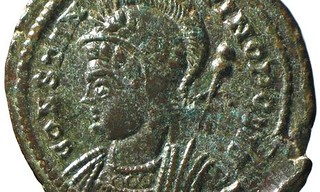
PREV ARTICLE
NEXT ARTICLE
FULL ISSUE
PREV FULL ISSUE
THE SEATON DOWN HOARD OF 22,000 ROMAN COINSThis article from The Guardian describes a recent Roman coin hoard find,
one of the largest hoards found in Britain. -Editor
Metal detector enthusiast Laurence Egerton discovered the haul of 22,000 fourth-century copper-alloy coins in Devon in November last year. After uncovering the coins on the Clinton Devon Estates, near Seaton Down, Egerton reported the find to the landowner and the local authority – and slept in his car for three nights to guard it. The hoard was then carefully removed in its entirety by a team of archaeologists. Over the past 10 months the coins have been lightly cleaned, identified and catalogued by experts from the British Museum. The Seaton Down hoard, which includes coins that are very well preserved, has been declared treasure by a coroner. The Royal Albert Memorial Museum in Exeter is now launching a bid to purchase the coins for public display in the city. Egerton spoke of his shock at finding the haul, which was located near a Roman villa and possible fort at the Honeyditches site. “Initially I found two small coins the size of a thumbnail sitting on top of the ground and then, as I began working in a grid formation in the surrounding area I had a 50-50 signal on the metal detector, which means that there is probably iron involved,” he said. “Most detectors are set up to ignore iron but I decided to dig the earth at that spot and immediately reached some iron ingots which were laid directly on top of the coins. “The next shovel was full of coins – they just spilled out over the field. “I had no idea how far down the coins went so I stopped immediately and phoned my wife to come to the site with a camera. “Under the terms of my licence, I contacted Clinton Devon Estates and Devon county council and was instructed to take away what was loose and then fill in the hole. Most of the coins are associated with Constantine I and his family, who became emperor while in Britain in AD306. Other coins date from the joint reign of Constantius II and his younger brother Constans, from AD337 to 40. Dr Roger Bland, from the British Museum, said: “It is one of the largest coin hoards of the fourth century ever found within the Roman empire but, despite the number of coins found, the financial value would not have been great, amounting to approximately four gold coins. To read the complete article, see:
David Sundman forwarded this story on the hoard from The Times, noting,
" If only other governments would model the British law..." -Editor
The “Seaton Down Hoard” of copper-alloy coins is one of the largest and best preserved 4th-century collections to have been found in Britain. It pales in comparison only with the 52,500 coins discovered by a hospital chef, also using a metal detector, in Frome, Somerset, in 2010. Bill Horner, an archaeologist at Devon county council, said: “The coins were in remarkably good condition. Coming out of the ground, you could see the portrait faces, a family tree of the House of Constantine.” The hoard was found near an excavated Roman villa in Honeyditches last November. Experts believe that the coins were buried by a soldier for safe keeping. The collection was announced yesterday at the British Museum, in London, which is displaying the coins alongside other artefacts recovered since the 1997 Portable Antiquities Scheme (PAS) was launched. The coins bring the number of items handed over to the PAS to one million. The scheme was devised on the back of the Treasury Act 1996, which made it an offence to keep discoveries a secret. Under the law, anyone who finds an artefact must report it to their local coroner within two weeks. The PAS allows members of the public, in particular people who use metal detectors, to report finds to their local council, which then passes details to the scheme so that it can decide whether the items are of historic importance. To read the complete article, see:
Wayne Homren, Editor The Numismatic Bibliomania Society is a non-profit organization promoting numismatic literature. See our web site at coinbooks.org. To submit items for publication in The E-Sylum, write to the Editor at this address: whomren@gmail.com To subscribe go to: https://my.binhost.com/lists/listinfo/esylum All Rights Reserved. NBS Home Page Contact the NBS webmaster 
|
